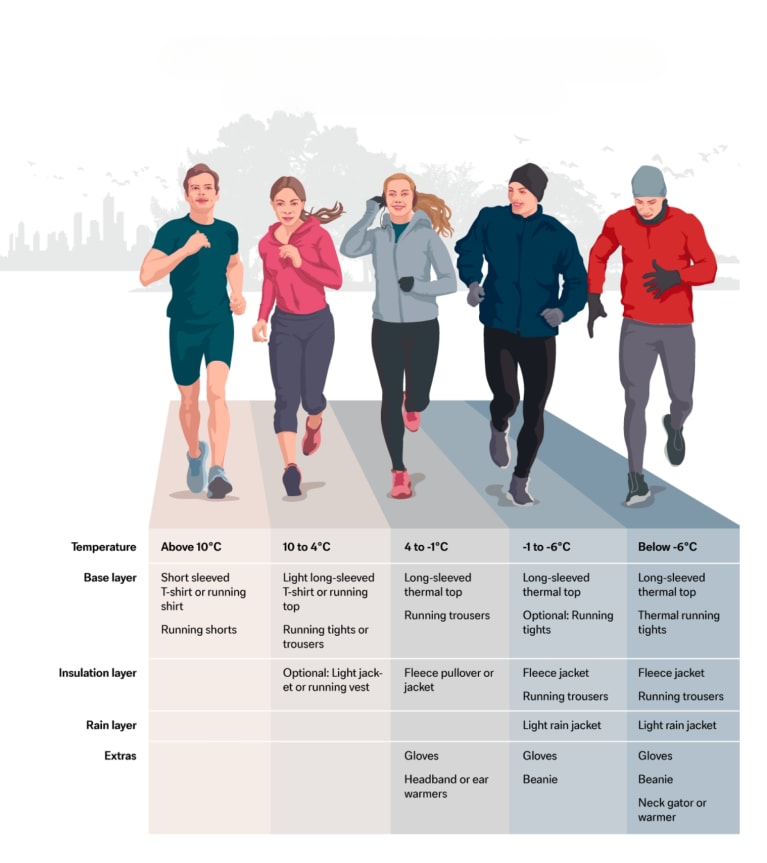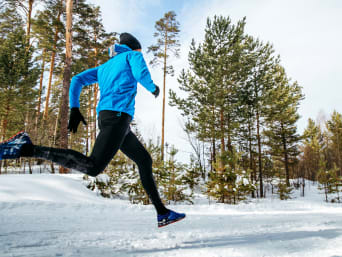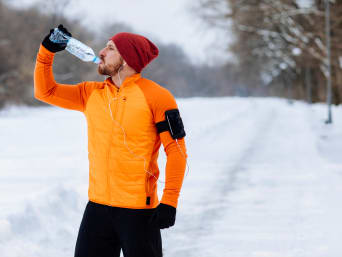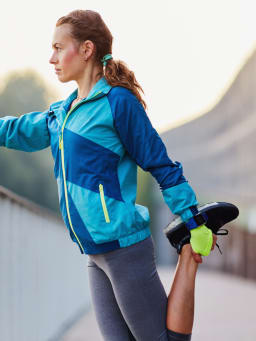Running in winter and autumn: tips for training and running clothes
With low temperatures and grey skies, some runners find it hard to motivate themselves to go for a run outdoors. However, exercising in the fresh air has some great advantages even in winter, for example, exercising outdoors can improve your mood. We will show you how to defy wind and weather when jogging in winter with the right running clothes. Warming up and cooling down will help to prevent any injuries. In this article we will give you some tips on what you should keep in mind when going on a run during the winter months.
Running in cold and wet conditions: how to strengthen your immune system
To keep up your training even in cold or drizzly weather, you should try to strengthen your immune system. Here are a few tips that will help you stay healthy during the cold season.
Remember to get enough sleep. We recommend about 6 to 8 hours of sleep per night, depending on your sleep pattern.
Eat a healthy and balanced diet. Carbohydrates provide energy, while seasonal fruits and vegetables such as apples, pears, nuts, cabbage and root vegetables provide you with valuable vitamins.
Make sure you drink enough. You can get dehydrated whilst jogging even in winter, so replenish your fluid levels regularly. However, your drink should not be too cold. Depending on what you like to drink, you could also try drinking lukewarm tea.
Recover thoroughly after a workout. A warm bath increases your well-being because the warmth relaxes your muscles after exercise. Regular sauna visits are also often recommended to strengthen your body's defence system.

You should not train with a cold because the strain can prolong the course of the illness or make it worse. Once you are feeling better you can start with light endurance training again.
Running in cold weather: how to adapt your training intensity
To take full advantage of the health benefits of running, you should adapt your training to the special demands of the cold season. This applies above all to the structure and intensity of your usual training.
Running in winter: recommendations for intensity
The more intense your training is, the deeper you will breathe in and out when you run. Deep breaths through your mouth can dry out the mucous membranes and irritate the bronchial tubes, especially in the cold winter air. Intense training sessions such as interval or tempo runs put too much strain on your airways in cold weather.
Instead, a relaxed endurance run is recommended in winter, during which you can still breathe through your nose without any problems. Cold air takes longer to reach your lungs when you breathe through your nose, however, the air is a lot warmer once it gets to your lungs. A light scarf in front of your mouth also helps to warm the air.
Since you can take in less air through your nose than through your mouth, you should reduce the intensity of your exercise. This will prevent shortness of breath or stitches whilst running.
At what temperature is it too cold to jog?
A bit of drizzle or even fresh snow shouldn’t deter you - but at what point is it too cold to run outdoors, even for seasoned runners? In general, experts recommend not jogging or running outdoors when temperatures drop below minus 10 °C. At colder temperatures, sufficient blood flow to muscles, tendons and ligaments becomes much harder, which increases the risk of injury.
You should check the outside temperature before going jogging and running. This will help you to decide whether it is too cold for a run. For many runners, humidity is also a decisive factor, as the air is clearer, and it is sometimes easier to breathe when the humidity is comparatively low.
Running in winter: how to adjust your warm-up and cool-down
In cold temperatures, muscles take longer to warm up. To avoid injuries and muscle strains, you should plan enough time for a thorough warm-up. Here's what to keep in mind when doing a warm-up and a cool-down in winter:
Make the warm-up a little longer and the cool-down a little shorter than in summer: plan at least 15 minutes for the warm-up and run loosely for about one minute at the end.
Stretch in a warmer place so that you don't cool down too much during the warm-up.
Run slowly before picking up the pace. Overall, your run should not reach the same intensity as in summer.
You can prevent sore muscles after a workout by taking it easy.
After your run, get warm quickly and change into dry clothes to reduce the risk of catching a cold.

Just half an hour of exercise in daylight stimulates the production of vitamin D and serotonin. Vitamin D is important for bone formation and muscle function, while serotonin influences balance and well-being. Both your immune system and your mood can benefit from winter training if you are properly prepared.
Tips for jogging in the dark
Depending on your training schedule, you may find yourself running at dusk or even in the dark in autumn and winter. There are some important safety tips to follow when jogging in the dark:
Wear light-coloured running clothes with reflectors. This can increase your visibility to other road users and runners by up to 150 metres.
Run along well-lit routes with little traffic. This will give you better visibility and help you judge the path ahead.
Try not to listen to music while running to be more aware of your surroundings.
If you often run in the dark, a headlamp or chest lamp are useful to have. You will be able to see the path, which will make you more sure-footed. Wearing a headlamp will also makes it easier for other road users to spot you.
Choose the right winter running clothes for wet and cold conditions
So that you can continue your running training even in cold temperatures or wet conditions, you will need the right running gear to protect you from the wind and bad weather.
Functional clothing for running in autumn and winter
Cold, wet and windy conditions place extra demands on your running clothes in autumn and winter. It is important that you stay dry and warm, but also that you do not overheat. The right functional clothing for winter should also ensure good visibility.
To be prepared for the autumn and winter months, you need the following equipment:
Light-coloured running clothes, preferably with reflectors
Wind- and water-repellent running jackets or vests and running trousers
Heat-regulating functional underwear and base layers
Warming and wind-resistant winter tights or thermal trousers
Accessories such as breathable running gloves, winter running socks, hat/headband and a multifunctional scarf/neck warmer
Running in the cold: basic rules for the right running clothing
The following rule of thumb is often used to determine the right running clothes: add ten degrees to the current outside temperature and you get the temperature you should dress for when jogging in winter. At the start of your run, you should be slightly cold, otherwise, you will quickly become too warm during your training.
Other weather conditions also influence how warm you should dress: fi there is a strong wind and overcast skies, you will feel colder than when it is sunny.
Wear lots of thin layers to help you warm instead of wearing thick winter clothing. This prevents you from overheating while running.
Breathable, water- and wind-repellent running clothes in winter wick moisture away from the body to prevent chilling and protect against the outside weather conditions.
Winter running clothes: how to dress for a winter run
You essentially combine three different layers of clothing depending on how cold or wet it is. It is important that each layer is breathable to prevent any heat from building up and to allow moisture to escape.

A distinction is made between the following important layers of functional clothing in winter:
Base layer: this layer lies directly on the skin and should ensure that you stay dry and warm. This includes functional underwear that is quick-drying and breathable.
Insulation layer: this layer helps regulate heat and provide thermal insulation, so its use naturally depends heavily on the outside temperatures. Warm clothes such as jumpers, jackets or trousers made of fleece work well.
Weather protection layer: this layer helps protect yourself from wind and moisture. Trousers, vests and jackets made of special windproof and waterproof material are part of the weather protection layer.
You can choose between softshell and hard-shell jackets. Softshell jackets are lighter and more elastic, windproof, water-repellent and keep you warm to a certain extent. Hard-shell jackets score points for higher water resistance but are usually somewhat less breathable.
Suitable running shoes for autumn and winter
To avoid slipping on wet leaves or slippery roads, you need shoes with a stronger, grippier tread and a thicker sole. At the same time, suitable breathable and waterproof winter running shoes will prevent your feet from getting wet. For particularly difficult or slippery terrain, there are also running shoes with special spikes for more grip. Although the tread of winter running shoes should provide a better grip, you should still try to take smaller steps than in summer.
In addition to a sturdy running shoe, you can buy winter running socks. Winter running socks are usually a little thicker and longer than normal running socks. However, special winter running socks are not a must if you are happy with your usual summer socks.

For many runners, the treadmill at the gym or home serves as an alternative in winter when it is too cold or rainy to jog outside. Keep in mind that the treadmill workout is slightly different from a normal running workout. Both the running motion and the steps are different, so you should stretch thoroughly afterwards.
Conclusion: how to jog safely during the winter months
For many avid runners, wind, drizzle or even snow is no reason to stop running in autumn and winter. With the right running clothes for winter, you should stay protected against harsher weather conditions and can continue to be active in the fresh air. However, it is also important to adapt your training intensity and your warm-up and cool-down routine to the colder temperatures to protect your muscles, tendons and ligaments from injury. This will help you to stay fit and healthy in the winter months.
______________________________________________
References and further information
https://www.healthline.com/health/winter-running#cold-weather-precautions
(Last accessed on 15.01.2024)
https://www.runnersworld.com/beginner/a20834718/the-newbie-guide-to-running-when-its-cold/
(Last accessed on 15.01.2024)
https://www.runtastic.com/blog/en/running-in-fall/
(Last accessed on 15.01.2024)
https://www.trainingpeaks.com/blog/12-common-winter-running-mistakes/
(Last accessed on 15.01.2024)
The image sources in this text are in chronological order:
1. Image in text:iStock.com/Alexander Chernyakov
2. Image in text: iStock.com/sportpoint
3. Image in text:iStock.com/Martinan
4. Image in text: iStock.com/mihailomilovanovic











